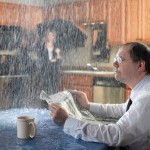Know Your Water Damage Categories
 Tuesday, July 20, 2010 at 11:30AM
Tuesday, July 20, 2010 at 11:30AM  Water damage is typically classified into one of the following three categories:
Water damage is typically classified into one of the following three categories:
Category 1 Water - Refers to a source of water that does not pose substantial threat to humans and classified as "Clean Water". Examples are broken water supply lines, tub or sink overflows or appliance malfunctions that involves water supply lines.
Category 2 Water - Refers to a source of water that contains a significant degree of chemical, biological or physical contaminants and causes discomfort or sickness when exposed or even consumed. Known as "Grey Water". This type carries micro organisms and nutrients of micro organisms. Examples are toilet bowls with urine (no feces), sump pump failures, seepage due to hydrostatic failure and water discharge from dishwashers or washing machines.
Category 3 Water - Known as "Black Water" and are grossly unsanitary. This water contains unsanitary agents, harmful bacteria and fungi, causing severe discomfort or sickness. Type 3 category are contaminated water sources that affects the indoor environment. This category includes water sources from sewage, seawater, rising water from rivers or streams, ground surface water or standing water. Category 2 Water or Grey Water that is not promptly removed from the structure and or have remained stagnant for 48-72 hours may be re classified as Category 3 Water. Toilet back flows that originates from beyond the toilet trap is considered black water contamination regardless of visible content or color.
Restoration: Different removal methods and measures are used depending on the category of water. Water damage restoration can be performed by property management teams, building maintenance personnel, or by the homeowners themselves; however, contacting a certified professional water damage restoration specialist is often regarded as the safest way to restore water damaged property due to their training and extensive experience.
 Buildings and Real Estate,
Buildings and Real Estate,  Commercial Property,
Commercial Property,  Community News,
Community News,  Education,
Education,  Emergency Planning,
Emergency Planning,  Flood Damage,
Flood Damage,  Insurance,
Insurance,  Storm Damage,
Storm Damage,  Training,
Training,  Water Damage,
Water Damage,  What Water Damage Is Covered By Insurance,
What Water Damage Is Covered By Insurance,  black water,
black water,  how to clean up after a water damage,
how to clean up after a water damage,  insurance coverage for water damage,
insurance coverage for water damage,  water,
water,  water damage categories,
water damage categories,  water damage coverage,
water damage coverage,  water damage drying,
water damage drying,  water damage from storm,
water damage from storm,  water damage mitigation,
water damage mitigation,  water damage restoration,
water damage restoration,  water damage to home,
water damage to home,  water removal
water removal  Email Article
Email Article 

Reader Comments